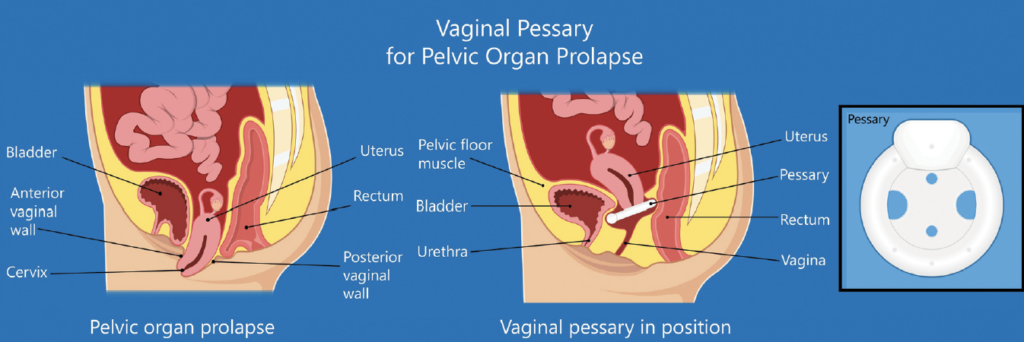What is a Pessary?

Written by Shawn Shanahan,
APRN-WHNP, Kalispell OB-GYN
I am often asked, “Why didn’t anyone ever tell me about pessaries?” One patient remarked, “They really are a game changer.” A pessary is typically a silicone rubber reusable device that is worn in the vagina. They come in many styles, shapes, and sizes because women come in many styles, shapes, and sizes. Pessaries are used to relieve symptoms of pelvic organ prolapse. Pelvic organ prolapse involves a loss of the support that holds the bladder, rectum, uterus, and/or bowels in their proper anatomical spaces.
Prolapse commonly occurs due to trauma to the pelvis from childbirth, a lifetime of heavy lifting or straining, or hard-impact activities like weightlifting, gymnastics or skydiving. Pelvic surgery can also weaken the pelvic support.
Sometimes the vagina bulges outside its entrance so that a woman may feel a lot of pelvic pressure, even back pain. It may feel like she “has something between her legs.”
When the bladder presses into the vagina, the urethral tube that transports urine to the outside of the body may be kinked, making it difficult to empty the bladder completely. When the bladder remains enlarged from the pressure of urinary retention over time, it can weaken and cause leakage. The woman may feel the need to urinate often with only a little urinary output.
Likewise, when the rectum protrudes into the vagina, a woman may experience constipation, rectal pressure, and fecal urge, like she has to have a bowel movement. Chronic straining, as with constipation or heavy lifting, may worsen the prolapse and lead to hemorrhoids or painful anal fissures, which are splits in the skin from passing hard, large stool. Avoiding chronic constipation to reduce the risk of prolapse can be accomplished by keeping stools soft and regular through regular exercise, routine intake of fiber and water, and the use of stool softeners.
The pessary pushes the vaginal walls back and can be helpful when these other organs, mentioned above, “fall” into the vagina. With a pessary in place, the wearer should be able to urinate and pass stool more normally and not feel the pessary, like wearing a tampon.
Physical Therapy
A specially trained pelvic floor physical therapist may help women with pelvic organ prolapse improve bowel and bladder function and reduce discomfort from the bulging organs. Targeted exercises, including Kegels and others, can strengthen the muscles of the pelvic floor, allowing for more successful pessary use. Thus, physical therapy is often prescribed in conjunction with a pessary.

Pessary Fitting
A pessary fitting is a lot like trying on shoes or clothing, though perhaps not as fun. It may take several fittings to get just the right one. Pessaries should not be worn during intercourse, so a sexually active woman would want a pessary she can insert, remove, and care for on her own. If worn over three months continuously, the vagina should be inspected for possible abrasions from the pessary moving as the wearer moves throughout the day.
Vaginal estrogen can decrease the risk of abrasions. This is typically a prescribed cream or suppository inserted into the vagina a couple of times a week to restore the elasticity and resilience of the vaginal walls and external genitalia to their premenopausal state. If a pessary does not stay in its proper place, the wearer should have another fitting.
An increase in vaginal discharge may occur with pessary use. Possible odor can be managed by simply washing the pessary with soap and water and soaking it in vinegar for 5 minutes periodically, or a vaginal gel can be prescribed to help. While odor and discharge are possible side effects of pessary use, these symptoms should be evaluated by a care provider to ensure there is no infection.
Schedule A Pelvic Assessment
In conclusion, prolapse is extremely common. You do not have to suffer in silence. If you want your outie to be an innie again, please call us, Kalispell OB/GYN, at 406–752–5252 for a pelvic assessment.
During your visit, you will be asked to describe any problems with urination or bowel movements as well as any pelvic pain, back pain, or pressure, including bulging in the genital area. You will then have a pelvic exam to determine whether the vaginal walls are falling inward from pressure from the bladder, rectum, intestines, or uterus. All treatment options would be discussed, primarily pelvic floor therapy, pessaries or surgery, and any combination of other treatments to help these work better, such as vaginal estrogen.
If a pessary is an option that may work for you based on pelvic support and lifestyle, a pessary fitting would be scheduled. There is no age limit to prolapse or pro-lapse care. Kegels and other exercises can help to prevent prolapse, as can learning to lift without stressing the pelvic floor.
Talk to your provider about referring you to a physical therapist for specialized pelvic floor preventative care. Lastly, pessaries are generally covered well by insurance, including Medicare and Medicaid.
So, what is stopping you from starting the conversation?
Originally published at 406 Woman Lifestyle VOL.16 No.2
Published on Sep 20, 2023
